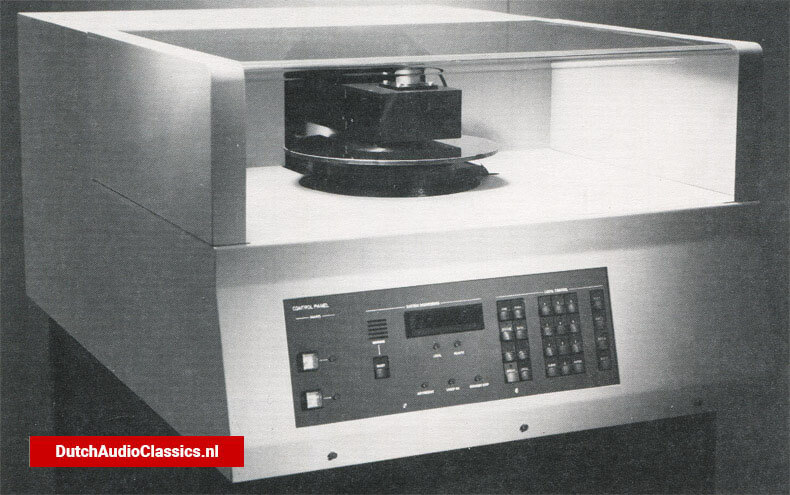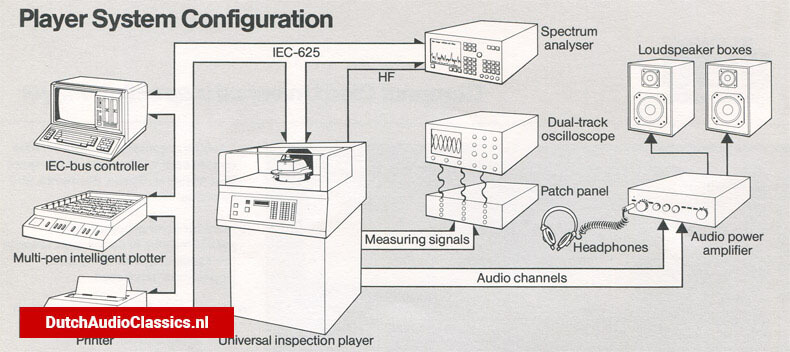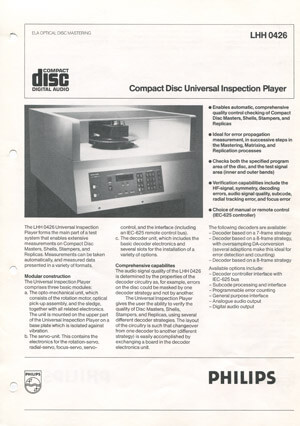Philips Compact Disc Digital Audio represent an outstanding advance in audio technology. It enables standards of reproduction, previously unattainable through traditional recording, mastering, and replication methods, to become a reality. This has been made possible through the development of techniques and equipment which enable audio information to be converted into a digital format, and transferred by optical means onto a disc. To achieve this breakthrough, Philips has used what is possibly today's most advanced tool...the laser...both in the Compact Disc Player itself and also in the mastering process. In addition, our extensive experience in audio technology, plus Philips worldwide research and development facilities have been combined to realise our aim for the optimum in sound reproduction...
Compact Disc Universal Inspection Player
- Enables automatic, comprehensive quality control checking of Compact Disc Masters, Shells, Stampers, and Replicas
- Ideal for error propagation measurements, in successive steps in the Mastering, Matrixing, and Replication processes.
- Checks both the specified program area of the disc, and the test signal area (inner and outer bands)
- Verification capabilities include the HF-signal, symmetry, decoding errors, audio signal quality, subocde, radial tracking error, and focus error
- Choice of manual or remote control (IEC-625 controller)

The Philips LHH0426 Universal Inspection Players forms the main part of a test system that enables extensive measurements on Compact Disc Masters, Shells, Stampers, and Replicas. Measurements can be taken automatically, and measured data presented in a variety of formats.
Modular construction
The Universal Inspection Player comprises three basic modules:
- The opto-mechanical unit, which consists of the rotation motor, optical pick-up assembly, and the sledge, together with all related electronics. The unit is mounted on the upper part of the Universal Inspection Player on a base plate which is isolated against vibration
- The servo-unit. This contains the electronics for the rotation-servo, radial-servo, focus-servo, servo-control, and the interface (including an IEC-625 remote control bus).
- The decoder unit, which includes the basic decoder electronics and several slots for the installation of a variety of options.
Comprehensive capabilities
The audio signal quality of the Philips LHH0426 is determined by the properties of the decoder circuitry as, for example, errors on the disc could be masked by one decoder strategy and not by another.
The Universal Inspection Player gives the user the ability to verify the quality of Disc Masters, Shells, Stampers, and Replicas, using several different decoder strategies. The layout of the circuitry is such that changover from one decoder to another (different strategiy) is easily accomplished by exchanging a board in the decoder electronics unit.
The following decoders are available:
- Decoder based on a 7-frame strategy
- Decoder based on a 8-frame strategy, with oversampling DA-conversion (several adaptions make this ideal for error detection and counting)
- Decoder based on a 8-frame strategy
Available options include:
- Decoder controller interface with IEC-625 bus
- Subcode processing and interface
- Programmable error counting
- General purpose interface
- Analogue audio output
- Digital audio output
Player system configuration
A typical system configuration is illustrated. Here, the test program which is stored by the user in the memory of the IEC-bus controller, evolves fully automatically. Output of the measured data is possible in a variety of forms - as plots on the mutli-pen intelligent plotter; tables or forms on the printer; or volatile data on the screen of the controller. It is also possible to monitor specific analogue signals on a dual trace oscilloscope for evaluation of signal properties.

Technical data
Dimensions and weight
Height: 11175mm
Depth: 860mm
Width: 660mm
Weight: approx 350kg
Accessoires
User manual; power cord; set of fuses
Mains voltage
110/220V +/-10%, 60/60Hz +/-4% user selectable
Power consumption
300VA
Evironmental conditions
Operating under dust-free conditions (class 100)
Temperature:
- operating: +15C to +35C
- non-operating: -20C to +70C
Relative humidity: 30-70% noncondensing
Optics
Wavelength: 800mm +/-20nm
Numerical aperture: 0,45
Diffraction limited optics
Linear polarisation
Nominal power readout spot 87 micro watt
Safety class 1 - according to regulations U.S. -dept. HEW (FDA)
Servos
Focus:
Mechanical range +/-0,8mm
Max.focus error 0,1 micrometer
Bandwidth 800Hz
Reduction at 13Hz > 57dB
Radial tracking:
Mechanical range: 18-60mm
Max.tracking error 0,1 micrometer
Bandwidth 500Hz
Reduction at 13Hz > 57dB
Rotation:
Range 3 to 13Hz
Bandwidth 12Hz
HF Pre-amplifier
Bandwidth: 0-5MHz
Noise: -80dBm at 500kHz (b.w. 10kHz)
Headphone amplifier
Load impedance 600 ohms
Max.output level +10dBm
THD -100dB
SNR -100dB
Terminal overview
HF-out: Analogue
Diode segment A: Analogue
Diode segment B: Analogue
Focus error: Analogue
Radial error: Analogue
Laser current: Analogue
Radius output: Analogue
Tacho/2: TTL
Rotation pulse: TTL
Marker signal output: TTL
Decoders error (decoder dependable): TTL
HFD (70% of HF-level): TTL
DOD (30% of HF-level): TTL
Subcode output: To be specified
Error valid output: TTL
Headphone output: Analogue
Audio output channel 1: Analogue
Audio output channel 2: Analogue
HF-input: Analogue
HF-clockout: TTL
Ext. word clock: TTL
IEC-625 remote control: Logic
Brochure Philips LHH0426
